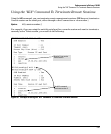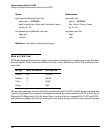
144
Enhancements in Release F.04.08
Configuring Rapid Reconfiguration Spanning Tree (RSTP)
Reconfiguring Per-Port Spanning Tree Values. You can configure one or more of the following
parameters, which affect the Spanning Tree operation of the specified ports only:
Table 10. Per-Port RSTP Parameters
Parameter Default Description
edge-port Yes Identifies ports that are connected to end nodes. During Spanning Tree estab-
lishment, these ports transition immediately to the Forwarding state.
In this way, the ports operate very similarly to ports that are configured in “fast
mode” under the STP implementation in previous HP switch software.
Disable this feature on all switch ports that are connected to another switch, or
bridge, or hub. Use the “no” option on the spanning tree command to disable
edge-port.
mcheck Yes Ports with mcheck set to true are forced to send out RSTP BPDUs for 3 seconds.
This allows for switches that are running RSTP to establish their connection
quickly and for switches running 802.1D STP to be identified.
If the whole-switch parameter Force-Version is set to “stp-compatible”, the
mcheck setting is ignored and STP BPDUs are sent out all ports.
Disable this feature on all ports that are known to be connected to devices that
are running 802.1D STP. Use the “no” option on the spanning tree command to
disable mcheck.
path-cost 10 Mbps – 2 000 000
100 Mbps – 200 000
1 Gbps – 20 000
Assigns an individual port cost that the switch uses to determine which ports
are the forwarding ports. The range is 1 to 200,000,000 or auto.
By default, this parameter is automatically determined by the port type, as shown
by the different default values. If you have previously configured a specific value
for this parameter, you can issue the command with the auto option to restore
the automatic setting feature.
Please see the Note on Path Cost on page 145 for information on compatibility
with devices running 802.1D STP for the path cost values.
point-to-
point-mac
force-true This parameter is used to tell the port if it is connected to a point-to-point link,
such as to another switch or bridge or to an end node (force-true).
This parameter should be set to force-false for all ports that are connected to a
hub, which is a shared LAN segment.
You can also set this parameter to auto and the switch will automatically set the
force-false value on all ports that it detects are not running at full duplex. All
connections to hubs are not full duplex.
priority 128
(8 as a step value)
This parameter is used by RSTP to determine the port(s) to use for forwarding.
The port with the lowest number has the highest priority.
The range is 0 to 240, but you configure the value by entering a multiple of 16.
You enter a value in the range 0 - 15. The default value of 128 is derived by the
default setting of 8.
Displaying the RSTP configuration (show spanning-tree config) shows 8, but
displaying the RSTP operation (show spanning-tree) shows 128.


















